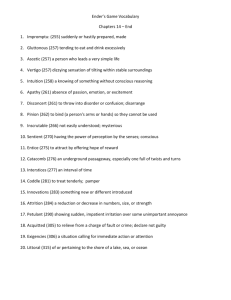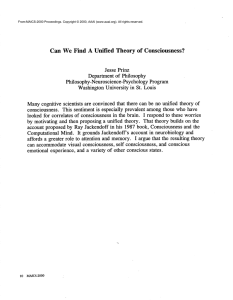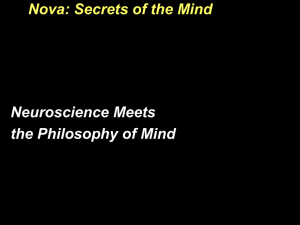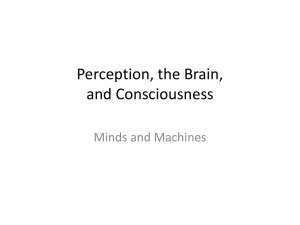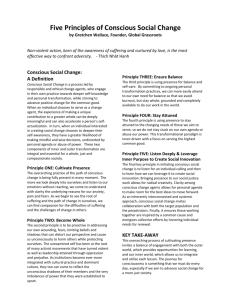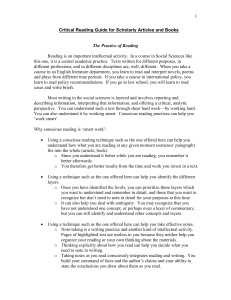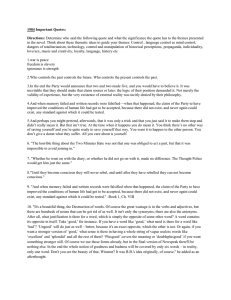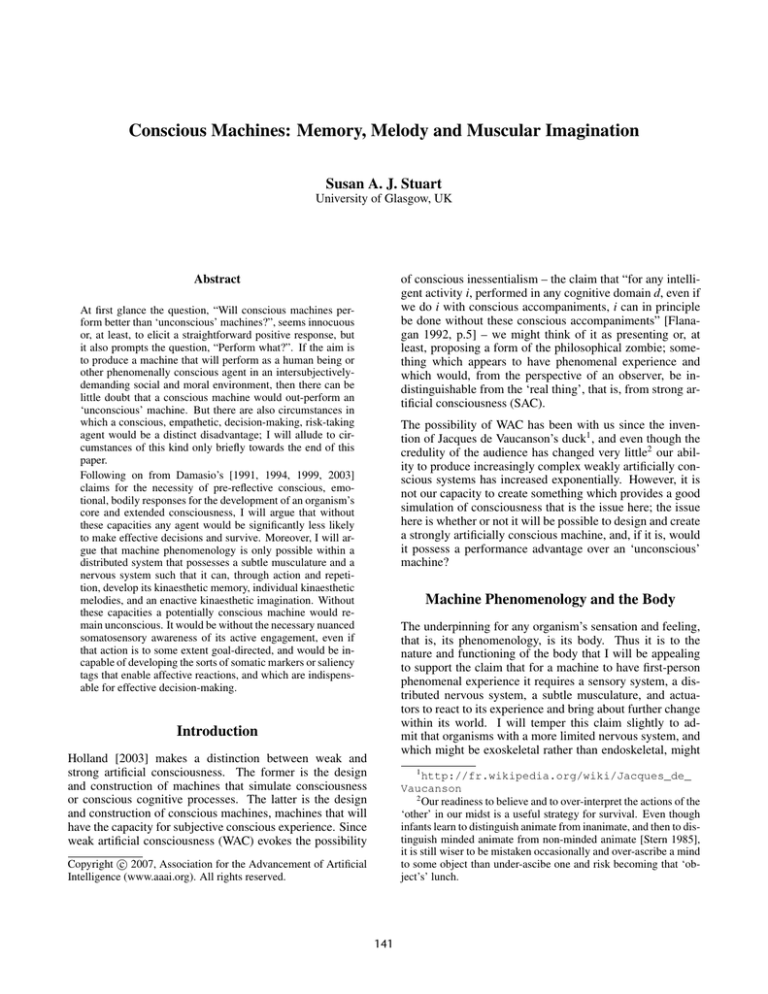
Conscious Machines: Memory, Melody and Muscular Imagination
Susan A. J. Stuart
University of Glasgow, UK
of conscious inessentialism – the claim that “for any intelligent activity i, performed in any cognitive domain d, even if
we do i with conscious accompaniments, i can in principle
be done without these conscious accompaniments” [Flanagan 1992, p.5] – we might think of it as presenting or, at
least, proposing a form of the philosophical zombie; something which appears to have phenomenal experience and
which would, from the perspective of an observer, be indistinguishable from the ‘real thing’, that is, from strong artificial consciousness (SAC).
Abstract
At first glance the question, “Will conscious machines perform better than ‘unconscious’ machines?”, seems innocuous
or, at least, to elicit a straightforward positive response, but
it also prompts the question, “Perform what?”. If the aim is
to produce a machine that will perform as a human being or
other phenomenally conscious agent in an intersubjectivelydemanding social and moral environment, then there can be
little doubt that a conscious machine would out-perform an
‘unconscious’ machine. But there are also circumstances in
which a conscious, empathetic, decision-making, risk-taking
agent would be a distinct disadvantage; I will allude to circumstances of this kind only briefly towards the end of this
paper.
Following on from Damasio’s [1991, 1994, 1999, 2003]
claims for the necessity of pre-reflective conscious, emotional, bodily responses for the development of an organism’s
core and extended consciousness, I will argue that without
these capacities any agent would be significantly less likely
to make effective decisions and survive. Moreover, I will argue that machine phenomenology is only possible within a
distributed system that possesses a subtle musculature and a
nervous system such that it can, through action and repetition, develop its kinaesthetic memory, individual kinaesthetic
melodies, and an enactive kinaesthetic imagination. Without
these capacities a potentially conscious machine would remain unconscious. It would be without the necessary nuanced
somatosensory awareness of its active engagement, even if
that action is to some extent goal-directed, and would be incapable of developing the sorts of somatic markers or saliency
tags that enable affective reactions, and which are indispensable for effective decision-making.
The possibility of WAC has been with us since the invention of Jacques de Vaucanson’s duck1 , and even though the
credulity of the audience has changed very little2 our ability to produce increasingly complex weakly artificially conscious systems has increased exponentially. However, it is
not our capacity to create something which provides a good
simulation of consciousness that is the issue here; the issue
here is whether or not it will be possible to design and create
a strongly artificially conscious machine, and, if it is, would
it possess a performance advantage over an ‘unconscious’
machine?
Machine Phenomenology and the Body
The underpinning for any organism’s sensation and feeling,
that is, its phenomenology, is its body. Thus it is to the
nature and functioning of the body that I will be appealing
to support the claim that for a machine to have first-person
phenomenal experience it requires a sensory system, a distributed nervous system, a subtle musculature, and actuators to react to its experience and bring about further change
within its world. I will temper this claim slightly to admit that organisms with a more limited nervous system, and
which might be exoskeletal rather than endoskeletal, might
Introduction
Holland [2003] makes a distinction between weak and
strong artificial consciousness. The former is the design
and construction of machines that simulate consciousness
or conscious cognitive processes. The latter is the design
and construction of conscious machines, machines that will
have the capacity for subjective conscious experience. Since
weak artificial consciousness (WAC) evokes the possibility
1
http://fr.wikipedia.org/wiki/Jacques_de_
Vaucanson
2
Our readiness to believe and to over-interpret the actions of the
‘other’ in our midst is a useful strategy for survival. Even though
infants learn to distinguish animate from inanimate, and then to distinguish minded animate from non-minded animate [Stern 1985],
it is still wiser to be mistaken occasionally and over-ascribe a mind
to some object than under-ascibe one and risk becoming that ‘object’s’ lunch.
c 2007, Association for the Advancement of Artificial
Copyright Intelligence (www.aaai.org). All rights reserved.
141
still be conscious of their environment, but not to the same
degree of phenomenality or with the same subtlety that a
more sophisticated endoskeletal system would be capable.
system. The foundational role in any phenomenally and
subjectively conscious system is performed, according to
Sheets-Johnstone, by the affective dynamic and tactilekinesthetic body coupled to its correlative kinetic world
[Sheets-Johnstone, 1999, 2000, & 2003]. It is this fullyimmersed coupling which makes integration possible, for
the very possibility of integration depends on a kinaesthetic
synthesis, that is, the formation of kinaesthetic and nervous patterns established through nuanced somatosensory
engagement and the repetition of self-directed muscular actions and reactions, all of which operates at a prereflective,
yet possibly intentional, bodily level.
It has been argued that the body plays a crucial role in providing “the unified, meaning-giving locus required to support and justify attributions of coherent experience”3 to the
agent, and it is its dynamically-coupled situatedness that expresses the integration of the system and its world; they are
separate but inseparable, possessing an interdetermination
that is demonstrated through continuous feedback loops of
sensation, action and reaction.
A strongly artificially conscious machine
Cotterill [1995] uses the wonderful word ‘plenisentience’
to describe the body’s being switched on to its world, perceiving, receiving, imagining, expecting and actuating. It
is an echo of Whitehead’s claim that “The essence of an
actual entity [conscious agent or, quite possibly, conscious
machine] consists solely in the fact that it is a prehending
thing.” [1929, p.56] Through sensors and receptors the system continuously prehends, grasps or becomes aware of incoming and internally transmitted stimuli and, in its movement and perceptual engagement it asks questions about how
the world will continue to be for it. This requires a lower,
non-self-conscious level of consciousness and expectation
that can only be described as ‘bodily’ and which situates the
system in its world.
. . . must be able to sense its world, bring about change
in its world, and distinguish itself from its world; and
for these abilities it will require sensing and actuating
systems. The former enables an agent to acquire information about its environment, working as an outer
sense, making it possible for the animat to determine
its external state. The part of the system that senses
the external world links, directly or indirectly, to actuators, making action, and hence interaction with the
world, possible. But in more complex agents ‘sensing’ will comprise an ‘inner sense’ that not only enables the agent to determine its goal(s) and compare its
sensory input with its current internal state(s), but also,
if the agent is to make appropriate decisions about its
action, to monitor its position in the world, its movement through the world and its actions within the world.
Such an agent [a SAC] will maintain a ‘body schema’
that will provide it with “continually updated, nonconceptual, non-conscious information about [its] body
... [providing] the necessary feedback for the execution
of... gross motor programs and their fine-tuning” (Meijsing, 2000, p. 39). [Dobbyn & Stuart 2003, pp.197-8]
In understanding the body’s capacity for conscious activity, and what would be required for an artificially created
conscious system to be subjectively aware of its experiences
as experiences for it, we must first distinguish between the
body as subject and the body as the object of consciousness,
and then we must examine how the two are mutually necessitated through enaction, that is, through the structural coupling that helps a conscious system to anticipate and enact
its prospective states; after all, it is enaction that brings forth
its world [Varela, et al. 1991].
The sense of both an inner ‘egocentric’ space [Brewer 1992]
and an affective depiction – the sensation of being ‘outthere’ [Aleksander & Dunmall 2003] – is formed through the
rich interplay of the body’s sensory channels that receive information about the environment4 , its actuating system that
enables manipulation of that environment, and its proprioceptive mechanisms which make it possible to sense the position, location, orientation and movement of the body and
its parts. All of these capacities are evident in the majority
of human and non-human animal species, and in some – still
rudimentary – machines.
A bodily consciousness of this kind is the result of an interplay between the agent’s body image, its body schema,
and its being and activity in its world. The terms ‘body image’ and ‘body schema’ were first distinguished by Head and
Holmes [1911], and further clarified by Gallagher [1986]. It
is a distinction for which there is now neurophysiological
evidence [Paillard 2005].
The body image is an “internal representation in the conscious experience of visual, tactile and motor information
of corporal origin” [Head and Holmes 1911], it comes directly through looking at or touching parts of our body, or
indirectly through our perception of, for example, our reflection in a mirror. On these occasions the body is both
the content of our conscious experience and the object of
our intentional activity and, as the object of thought, it lacks
the transparency – the immediacy and lack of self-conscious
awareness – that the body possesses as subject. The body
schema as a pre-attentional, non-self-consciously monitored [Merleau-Ponty 1962] “real-time representation of the
body in space generated by proprioceptive, somatosensory,
vestibular and other sensory inputs” [Schwoebel et al. 2001]
The sort of experiential integration made possible at this
level is neither necessarily conceptual nor cognitive though
it has the potential to become both in the right kind of
3
http://www.consciousness.it/CAI/CAI.htm
Viz. Johnson 1990; Chiel & Beer 1997; Clarke 1997; Damasio
1999; Lakoff & Johnson 1999; Seitz 2001; Dobbyn & Stuart
2003; Legrand 2006; Ziemke 2003 & 2007; amongst a great many
others.
4
The concept of ‘environment’ is used thickly to refer to the
system’s world and its own variable internal states that are the subject of homeostatic functions.
142
possesses this transparency.
location and severity of the damage, SCI can result in restricted or absent sensory and sensory-motor input and can,
sometimes, be accompanied by, mostly, visual hallucinations. Thus, in the absence of direct afferent input and efferent feedback from the somato-sensory motor cortex, the
brain compensates and activation from the visual regions is
likely to overlap, even invade, an area of inactivity. However, in some cases the brain, left without sensation, imagines or creates the sensation of pain, often severe and usually situated below the level of the lesion. “Pain, a particular
form of imagination of sensory experience without sensory
input from the periphery, is a vicious way the brain extracts
revenge for being left without sensation” [Cole 2005, p.191];
yet through this revenge the agent once again feels situated
in their world.
The body schema is “a combined standard against which all
subsequent changes of posture are measured . . . before the
changes of posture enter consciousness” [Head and Holmes
1911]. It is extra-intentional, subconscious, subpersonal
and unowned, operating through a set of sensori-motor laws
which are “constraining and enabling factors that limit and
define the possibilities of intentional consciousness” [Gallagher 1995 p.239] making perception and action possible.
It remains hidden phenomenologically from the agent, and is
set in stark contrast with the sensory images that go to make
up the body image. The body schema “organizes the body as
it functions in communion with its environment” [Gallagher
1985, p.549] as it actively, and mostly unconsciously, organises its perceptual experience in relation to its pragmatic
concerns [Merleau-Ponty 1962; Heidegger 1968].
A still clearer case for the necessity of affection and action is
provided by the example of people who have fully-sentient
heads but unfelt bodies and who experience themselves as
‘floating’ unthethered from their body. [Cole 2005, p.185]
There can be little doubt that whatever subjective, phenomenal consciousness they experience it is ungrounded, unsituated, and unembodied.
The essential role of the body and its dynamic self-directed
movement in the generation of consciousness can be established by examining what happens to an agent’s consciousness when their body has lost its proprioceptive ability. It
is not unusual in cases of such severe deafferentation for a
diminution of the sense of self to follow. It is as though
the agent’s capacity to draw together or integrate their identity has also evaporated, and it is only when they are able
to replace their internal feedback system with an external
feedback system, most usually their visual sense, that they
become able to move – with a great deal of concentration
– and regain their sense of self or identity.5 It seems that
just as our eye is not our servant but our ambassador [Ings
2007], so too is our body; that just as our eyes are ceaselessly active, questioning and interrogating our world, so
too is our body, and in the absence of afferent stimulation
the body loses its integrity and only the eye with its incessant inquiry can provide some compensatory evidence for
the agent’s bodily perdurance. Thus, it is is not just the passively received information about a changing environment,
but the interplay between this information and active selfmovement that places the self, an integrated and coherent
unity, firmly at the centre of its world [Meijsing, 2000].
A much less severe, though nonetheless significant, example
is provided by Oliver Sacks and describes the phenomenality
of severe nervous and muscular damage to his knee. “When
I looked straight ahead, I had no idea where my left leg was,
nor indeed any definite feeling of its existence. I had to look
down, for vision was crucial. And when I did look down I
had momentary difficulty in recognizing the ‘object’ next to
my right foot as my left foot. It did not seem to ‘belong’ to
me in any way.” [Sacks 1984, p.137]
In each of these cases there has been damage to the body
in the form of damage to the nervous system and subsequent
damage to the individual’s body schema.6 Each case demonstrates that the body, with its subtleties of sensing and perceiving – its nuanced somatosensory awareness – combined
with its capacities for self-directed movement and actuation,
is capable of (i) creating and establishing a feeling of how
and where the system is, its extent and limitation – its depiction [Aleksander & Dunmall 2003] – and also for (ii) anticipating how it might be in its world, that is, how it might act
given its awareness and selection of those things that have a
particular affordance for it. [Gibson 1968 & 1979]
In a very similar way locked-in syndrome, with its lesion
to the brain stem and damage to the under side of the pons,
provides another example of the evaporation of an integrated
and depicted subject. In this short passage Jean-Dominique
Bauby quotes a half-imaginary exchange with his friend Florence: “‘Are you there, Jean-Do?’ she asks anxiously over
the air. And I have to admit that at times I do not know any
more.” [Bauby 1997, pp.49-50]
Enactivity is evident in both (i) and (ii), but it is a bodily
or kinaesthetic enactivity that produces non-conceptual yet
intentional anticipations for how the agent and its world are
currently, and how the agent and its world could be should
certain potential changes come to pass. None of this enactivity need be conscious or conceptual though under certain circumstances, perhaps of heightened tension or attention, it might be. Think only of attempting to walk silently
across a forest floor. The awareness of every movement is
intense. The flexing of each muscle is the subject of minute
attention. The vigilance with which we scan our surroundings and place each foot is concentrated and precise, and
A normal level of sensory bombardment is also absent in
patients with spinal cord injury (SCI). Depending on the
5
‘Oliver Sacks remarks (in the ‘Forward’ to Cole, 1991) that
the case of IW “shows how such a peripheral disorder can have the
profoundest ‘central’ effects on what Gerald Edelman called the
‘primary consciousness’ of a person: his ability to experience his
body as continuous, as ‘owned,’ as controlled, as his. We see that a
disorder of touch and proprioception, itself unconscious, becomes,
at the highest level, a ‘disease of consciousness”’ (xiii).’ [Gallagher
& Cole (1995), Footnote 7]
6
There may also have been some corresponding effect on the
individual’s body image but this cannot be an issue here.
143
the judgement of the likelihood of this twig snapping or that
twig bending is made with great diligence. But this kind of
scenario is rare. In most of our activity and actuation we rely
on the body’s natural propensity to automate habituated kinaesthetic activity. The seamless use of any tool, to run and
skip, to sign our name, or to throw a curveball is the result
of our capacity to memorise and form fluent, non-cognitive
melodic movements. [Stuart 2007] As Luria says “with the
development of motor skills the individual impulses are synthesized ... into integral kinaesthetic structures or kinetic
melodies.” [Luria 1973, p.176] Thus it is through sensation,
action and repetition that the agent develops an enactive kinaesthetic imagination, its kinaesthetic memory, and its own
unique individual kinaesthetic melodies. Such melodies can
correspond to gross motor skills but they can also correspond to subtle and more local bodily affective activity, for
example, the unreflexive or ‘gut’ response that provides us
with a pre-cognitive ‘feeling’ about potential actions. In
terms of effective decision-making, consciousness, even at
this bodily level, presents a significant advantage for any situated and embodied agent.
capacity to tag in this manner is formed through our experience of primary inducers, for example, direct or immediate
experience of something dangerous, which establish in us a
network of secondary inducers making it possible for us to
recall in similar future situations – though not necessarily
consciously for that would hinder the speed of our reactions
– the sensation we had on experiencing the primary inducer
and now disposing us to react with appropriate caution or
incaution to whatever it is we now experience. Thus patterns of bodily affective actions speed up effective decisionmaking in the same and similar future contexts.
The feelings we have as a response to these emotions can
be conscious or unconscious, but when conscious they represent the relation of the emotion to ourselves as agents in
the world. In Damasio’s language and theory this is expressed through the relation of the proto-self to the coreconscious self, or core-consciousness. So, there is some
‘primary mode of being’ [Heidegger 1962] which is phenomenologically and ontologically prior to, and necessary
for, the formation of a core-consciousness, and the “absence
of emotion [the primary mode of being] is [or can be taken
to be] a reliable correlate of defective core consciousness”.
[Damasio 2003, p.100]
The Somatic Marker Hypothesis
Several areas of the brain are crucial for effective decisionmaking; they include the amygdala, the anterior cingulate
cortex, the brain stem, the hypothalamus and the ventromedial prefrontal cortex [vmPFC]. The vmPFC mediates between the limbic system and the cerebral cortex and damage
to it can leave the subject intellectually unimpaired yet incapable of making ordinary everyday decisions in real-life
situations. Damasio quotes patient EVR as having suffered
damage to the vmPFC and to the connection between the
amygdala and the hypothalamus. As a result EVR is incapable of making a decision about trivial matters like where
he should go for dinner for he becomes overwhelmed by irrelevant information. He is incapable of tagging and prioritising informational criteria as relevant or irrelevant for all
criteria carries the same emotional weight.
Over the last two decades Antonio Damasio has presented
a consistently forceful case for the role of the body, and
specifically for the emotions, in effective decision-making.
[Viz. Damasio et al. 1991; Damasio 1994, 1999, & 2003;
and Damasio et al. 2000] According to his theory, emotions
– defined as spontaneous neural and chemical responses to
changes in the agent’s physiological state – play a central
role in the agent’s homeostatic functioning. “[T]he subjective process of feeling emotions is partly grounded in dynamic neural maps, which represent several aspects of the
organism’s continuously changing internal state”. [Damasio et al. 2003, p.1049] They are the body’s pre-reflective,
pre-cognitive affective activity which act to underpin the development of the agent’s successful adaptive behaviour.
It is impossible, in this paper, to go into the finer details of
Damasio’s breakdown of emotions into six primary (universal) emotions [Viz. Ekman 1992]; a number of secondary
(social) emotions, for example, embarrassment and pride;
and background emotions, for example, calm or tension, anticipation or dread; but even simply stating them goes some
way to demonstrate the manifest complexity and subtlety of
the phenomenally conscious subject.
This kind of day-to-day affective activity and effective
decision-making requires a phenomenally conscious agent.
But if our system is, in fact, a façade of conscious engagement, a WAC, it will have no capacity for creating and establishing a feeling of how and where it is, or for anticipating, pre-cognitively yet affectively, how it might be. There
can be little doubt that, as a consequence, it will be much
less efficient than a phenomenally conscious, subjectively
aware system. With no sensation a WAC has no affective
somatosensory, motor, and efferent feedback system, it will
be unable to develop the sorts of somatic markers or saliency
tags that enable affective responses and, thus, the formation
and reformation of adaptive behaviours and strategies. Without these a WAC will either take an unconscionable amount
of time because it will be unable to decide between equallyweighted items, becoming a modern-day Buridan’s ass, or it
will make a decision that could impact unfavourably on its
continued survival. It will have no natural feel for itself in
its world; there won’t be a world for it; indeed, there won’t
be an it.
Decision-making in such a subject isn’t simply a cognitive
and evaluative process involving a judgement about how
best to reach the desired goal; it is also a matter of determining the emotional salience a state of affairs or potential
action has for the agent. Thus, it requires sensory and affective elements and, only on some occasions, perhaps involving the secondary social emotions, will it also require a
cognitive element. Without an affective element the agent
will be unable to rank the items to be judged in order of
their significance to her directly, or to her indirectly by the
affect they are likely to have on those about whom she is
concerned. This ranking is termed ‘saliency tagging’ and the
144
Phineas Gage is the best example of someone who falls into
the latter category as being perfectly able to continue to
make decisions, but which ceased to be effective. [Damasio
et al. 1994]. Phineas Gage could not be considered equivalent to a WAC, he remained conscious, even through and
after his accident, but the damage to his vmPFC left his social action and interaction very seriously impaired. An account from his own doctor reveals that he went from being
a hard-working and reliable family man to a confabulator
whose decision-making skills were limited to the formation
of unrealistic schemes.
Placing a WAC in the SAC social environment, where judgements and decisions have to be made in real-time and concerning the well-being of the machine and relevant others,
is destined to fail. It can neither feel nor think. In these circumstances the zombie, the WAC, is an evolutionary deadend, and the answer to the question “Will conscious machines perform better than ‘unconscious’ machines?” must
be ‘Yes’. But there are times when a phenomenally affective conscious agent can entail ineffective decision-making,
and where the operation of an unconscious machine would
be preferable.
His contractors . . . considered the change in his mind
so marked that they could not give him his place again.
He is fitful, irreverent, indulging at times in the grossest
profanity . . . manifesting but little deference for his fellows, impatient of restraint or advice when it conflicts
with his desires, at times pertinaciously obstinate, yet
capricious and vacillating, devising many plans of future operation, which are no sooner arranged than they
are abandoned . . . . [Harlow 1848]
In the case of the mid-air collision of the Bakshirian Airlines
Tupolov 154 and the DHL Boeing 757 on 1 July 2002 the
pilots gave the conscious human flight controller the benefit
of the doubt as he over-ruled the ‘unconscious’ ACAS IIcompliant collision-avoidance system’s message; had they
not, the disaster might just have been avoided.
After the cortical damage Gages chances of survival outside
the protection of his social group would have been extremely
limited. Not only had he lost any sensitivity to, or capacity for, informative visceral responses, but in his devising of
wild schemes and lack of consideration for others he seemed
also to have lost his basic endogenous intersubjectivity [Gallagher 2007], the practical knowledge of oneself that guides
one’s actions from the inside out.
Aleksander, I. & Dunmall, B. (2003) ‘Axioms and Tests for
the Presence of Minimal Consciousness in Agents’, Journal
of Consciousness Studies, 10 (4-5), pp.7-18
Damasio’s account does not rule out the evaluative capacity that we associate with judgement, it’s just that it comes
much later on and at a much higher, possibly consciously
cognitive, level as the result of reflection and feeling, where
feeling is “the realization of a nexus between an object and
an emotional body state’ [Damasio 1994, p.132]. It would
be hoped that with the creation of a SAC the reflexive evaluative capacity would emerge through the ongoing felt dynamics of the agent’s social action and interaction but, as
Damasio [2003] has shown, damage to certain regions of
the frontal lobe in young children can inhibit the development of social emotions, like compassion, shame, and guilt;
the very emotions we tend to associate with mature subjective reflection, evaluation and judgement.
Chiel, H.J. & Beer, R.D. (1997) ‘The brain has a body:
Adaptive behavior emerges from interactions of nervous
system, body and environment’, Trends in Neurosciences 20,
pp.553-7
Bibliography
Bauby, J-D. (1997) The Diving-Bell and The Butterfly, London: Fourth Estate, Harper Perennial 2004
Brewer, B. (1992) ‘Self-Location and Agency’, Mind 101,
pp.17-34
Clark, A. (1997) Being there: putting brain, body, and world
together again, Cambridge, Mass.; London: MIT Press
Cole, J. (1995) Pride and a daily marathon, Cambridge,
Massachusetts: MIT Press; orig. 1991 London: Duckworth
Cole, J. (2005) ‘Imagination after neurological losses of
movement and sensation: The experience of spinal cord
injury’, Phenomenology and the Cognitive Sciences, 4 (2)
pp.183-195
Cotterill, R. M. J. (1995) ‘On the unity of conscious experience’, Journal of Consciousness Studies, Imprint Academic,
Vol. 2, No. 4, pp.290-311
Conclusion
We began with the doctrine of conscious inessentialism
and the possibility of building a machine that could do everything that a phenomenally conscious subjective agent
could but without the phenomenal subjectivity. But conscious inessentialism is a false doctrine; a WAC could never
succeed in a SAC environment for the effective decisionmaking activity of a SAC requires the very thing that conscious inessentialism denies: it requires a self-directed active, dynamically-coupled agent with a capacity for affective bodily activity that makes possible the development and
automatisation of appropriate responses and adaptive behaviours in social and moral environments.
Cotterill, R. M. J. (1998) Enchanted Looms: Conscious
Networks in Brains and Computers, Cambridge University
Press
Damasio, A.R., Tranel, D. & Damasio, H. (1991) “Somatic
markers and the guidance of behaviour: theory and preliminary testing”, (pp. 217-229). In H.S. Levin, H.M. Eisenberg
& A.L. Benton (Eds.). Frontal lobe function and dysfunction. New York: Oxford University Press
Damasio H., Grabowski T,. Frank R., Galaburda AM.,
Damasio AR. (1994) ‘The return of Phineas Gage: clues
145
Lakoff, G. & Johnson, M. (1999) Philosophy in the Flesh :
The Embodied Mind and Its Challenge to Western Thought,
New York: Basic
about the brain from the skull of a famous patient’, Science,
264 (5162), pp.1102-5
Damasio, A.R. (1994) Descartes’ Error: emotion, reason,
and the human brain, New York: Grosset/Putnam
Legrand, D. (2006) ‘The Bodily Self: The Sensori-Motor
Roots of Pre-Reflexive Self-Consciousness’, Phenomenology and the Cognitive Sciences, 5 (1), pp.89-118
Damasio, A.R. (1999) The feeling of what happens : body,
emotion and the making of consciousness, New York: Harcourt Brace
Luria, A. R. (1973) The Working Brain: an introduction to
neuropsychology, trans. Basil Haigh, London: Allen Lane
Damasio, A.R., Grabowski, T.J., Bechara, A., Damasio, H.,
Ponto, L.L.B., Parvizi, J., & Hichwa, R.D.(2000) “Subcortical and cortical brain activity during the feeling of selfgenerated emotions”, Nature Neuroscience, 3 (10) pp.104956, October 2000
Meijsing, M. (2000) ‘Self-Consciousness and the Body’,
Journal of Consciousness Studies, 7 (6), pp.34-52
Merleau-Ponty, M. (1962) Phenomenology of Perception,
trans. by Colin Smith, London: Routledge & Kegan Paul;
New York: The Humanities Press
Damasio, A.R. (2003) Looking for Spinoza : joy, sorrow,
and the feeling brain, London: Harcourt
Paillard, J. (2005) ‘Vectorial versus configural encoding of
Body Space, A neural basis for a distinc- tion between Body
schema and Body image’, V.Knockaert & H. De Preester
(eds) Body Image and Body Schema: Interdisciplinary perspectives, (pp. 89-109), John Benjamin, Amsterdam
Dobbyn, C. & Stuart, S.A.J. (2003) ‘The Self as an Embedded Agent’, Minds and Machines, 13 (2) pp.187-201
Ekman, P. (1992) ‘Facial expressions of emotions: New
findings, New questions’, Psychological Science, 3 (1),
pp.34-8
Sacks, O. (1984) A Leg to Stand On, Perennial Library,
Harper and Row Publishers
Flanagan, O. (1992) Consciousness Reconsidered, Cambridge, MA: MIT Press
Schwoebel, J., Friedman, R., Duda, N., & Coslet, H. B.
(2001) ‘Pain and the body schema: Evidence for peripheral
effects on mental representations of movement’, Brain, 124
(10), pp.2098-2104
Gallagher, S. (1986) ‘Body image and body schema: A Conceptual Clarification’, Journal of Mind and Behavior, 7 (4),
pp.541-554
Seitz, J. A. (2000) ‘The Bodily Basis of Thought’, New
Ideas in Psychology: An International Journal of Innovative Theory in Psychology, 2000, 18(1), pp.23-40
Gallagher, S. & Cole, J.D. (1995) “Body Schema and Body
Image in a Deafferented Subject”, Journal of Mind and Behavior, 16, pp.369-390
Sheets-Johnstone, M. (1999) The Primacy of Movement,
Amsterdam: J. Benjamins
Gallagher, S. (2007) ‘Moral Agency, Self-Consciousness
,and Practical Wisdom’, Journal of Consciousness Studies,
14 (5-6), pp.199-223
Sheets-Johnstone, M. (2000) ‘Kinetic Tactile-Kinesthetic
Bodies: ontogenetical foundations of apprenticeship learning’ Human Studies, 23, pp.343-70
Gibson, J.J. (1968) The Senses Considered as Perceptual
Systems, London, George Allen & Unwin
Sheets-Johnstone, M. (2003) ‘Kinesthetic Memory’, Theoria et Historia Scientiarum, 7, pp.69-92
Gibson, J.J. (1979) The ecological approach to visual perception, Boston, Mass.: Houghton Mifflin
Stern, D. (1985) The Interpersonal World of the Infant: A
View from Psychoanalysis and Developmental Psychology,
New York: Basic Books
Harlow, J.M. (1848) ‘Passage of an iron rod through the
head’, Boston Medical and Surgical Journal 39, pp.389-93.
(Republished Journal of Neuropsychiatry and Clinical Neuroscience, intro. by T.C. Neylan ‘Frontal Lobe Function: Mr
Phineas Gage’s Famous Injury’, (1999) 11 (2), pp.281-83)
Stuart, S. (2007) ‘Machine Consciousness: Cognitive and
Kinaesthetic Imagination’, Journal of Consciousness Studies, 14 (7), pp.141-53
Head, H. & Holmes, G.M. (1911) ‘Sensory disturbances
from cerebral lesions’, Brain, Oxford, Vol. 34: 102-254
Varela, F., Thompson, E., & Rosch, E. (2003) The Embodied Mind: Cognitive Science and Human Experience, MIT
Press, Cambridge, MA
Heidegger, M. (1962) Being and Time, trans. John Macquarrie & Edward Robinson, London: SCM Press
Whitehead, A. N. (1929) Process and Reality, Cambridge:
Cambridge University Press
Holland, O. (2003) Machine Consciousness, New York, Imprint Academic
Ings, S. (2007) The Eye: A Natural History, London:
Bloomsbury Publishing
Ziemke, T. (2003) ‘What’s that thing called embodiment?’,
Proceedings of the 25th Annual Meeting of the Cognitive
Science Society, Lawrence Erlbaum
Johnson, M. (1990) The Body in the Mind: The Bodily Basis
of Meaning, Imagination, and Reason, London: University
of Chicago Press
Ziemke, T. (2007) ‘Whats life got to do with it?’, in: Chella
& Manzotti (eds.), Artificial Consciousness (pp. 48-66), Exeter: Imprint Academic
146

